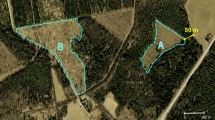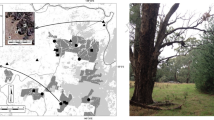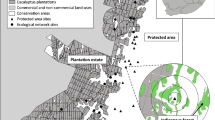Abstract
Although patch isolation and patch size have long been considered the two primary parameters affecting metapopulation processes, patch quality is now recognized as a third factor. The extent to which patch quality influences between-patch migration processes and local population sizes, however, is poorly understood. Using a mark–recapture survey for the butterfly Minois dryas, which inhabits grasslands in a fragmented landscape, we investigated factors affecting immigration and emigration of female individuals between patches. For patch quality, we assessed the proportion of forest-edge length along the patch periphery, as well as nectar resource availability, as the former is known to provide shelter from heat stress for grassland butterflies in midsummer. Results revealed that immigration into patches was largely determined by patch quality represented by forest–grassland adjacency, in addition to patch isolation. Emigration was lower from patches with high-quality measured by nectar resource availability as well as the amount of surrounding forest. These results suggest that a forest–grassland boundary is important, even for grassland-dwelling butterflies, in fragmented landscapes, and that conservation priorities should be given to habitats having this structural feature, as well as large patch size and high connectivity.




Similar content being viewed by others
References
Baguette M, Clobert J, Schtickzelle N (2011) Metapopulation dynamics of the bog fritillary butterfly: experimental changes in habitat quality induced negative density-dependent dispersal. Ecography 34:170–176
Bartoń K (2014) MuMIn: multi-model inference. R package version 1.10.5
Brückmann SV, Krauss J, Steffan-Dewenter I (2010) Butterfly and plant specialists suffer from reduced connectivity in fragmented landscapes. J Appl Ecol 47:799–809
Burgess SC, Treml EA, Marshall DJ (2012) How do dispersal costs and habitat selection influence realized population connectivity? Ecology 93:1378–1387
Burnham KP, Anderson DR (2002) Model selection and multimodel inference: a practical information-theoretic approach. Springer, New York
Cant ET, Smith AD, Reynolds DR, Osborne JL (2005) Tracking butterfly flight paths across the landscape with harmonic rader. Proc R Soc B 272:785–790
Choquet R, Reboulet A-M, Pradel R, Gimenez O, Lebreton J-D (2005) M-SURGE 1.8 user’s manual, pp 1–50
Clinchy M, Haydon DT, Smith AT (2002) Pattern does not equal process: what does patch occupancy really tell us about metapopulation dynamics? Am Nat 159:351–362
Cooch E, White G (2010) Program MARK, pp 1–837
Cozzi G, Müller CB, Krauss J (2008) How do local habitat management and landscape structure at different spatial scales affect fritillary butterfly distribution on fragmented wetlands? Landsc Ecol 23:269–283
Dennis RLH, Shreeve TG, Van Dyck H (2003) Towards a functional resource-based concept for habitat: a butterfly biology viewpoint. Oikos 102:417–426
Fleishman E, Ray C, Sjogren-Gulve P, Boggs CL, Murphy DD (2002) Assessing the roles of patch quality, area, and isolation in predicting metapopulation dynamics. Conserv Biol 16:706–716
Hanski I (1994) A practical model of metapopulation dynamics. J Anim Ecol 63:151–162
Hodgson JA, Moilanen A, Thomas CD (2009) Metapopulation responses to patch connectivity and quality are masked by successional habitat dynamics. Ecology 90:1608–1619
Imura O (2008) Evaluating potential risk of Japanese grassland butterflies for conservation by analyses of Red lists. Jpn J Grass Sci 54:45–56 (in Japanese)
Japan Butterfly Conservation Society (2012) Field guide to the butterflies of Japan. Seibun-do, Tokyo (in Japanese)
Jaquiery J, Guelat J, Broquet T, Berset-Brandli L, Pellegrini E, Moresi R, Hirzel AH, Perrin N (2008) Habitat-quality effects on metapopulation dynamics in greater white-toothed shrew, Crocidura russula. Ecology 89:2777–2785
Kalarus K, Skórka P, Nowicki P (2013a) Resource use in two contrasting habitat types raises different challenges for the conservation of the dryad butterfly Minois dryas. J Insect Conserv 17:777–786
Kalarus K, Skórka P, Halecki W, Jirak A, Kajzer-Bonk J, Nowicki P (2013b) Within-patch mobility and flight morphology reflect resource use anddispersal potential in the dryad butterfly Minois dryas. J Insect Conserv 17:1221–1228
Kuroe M, Yamaguchi N, Kadoya T, Miyashita T (2011) Matrix heterogeneity affects population size of the harvest mice: Bayesian estimation of matrix resistance and model validation. Oikos 120:271–279
Lebreton J, Pradel R (2002) Multistate recapture models: modelling incomplete individual histories. J Appl Stat 29:353–369
Matter SF, Roland J, Moilanen A (2004) Migration and survival of Parnassius smintheus: detecting effects of habitat for individual butterflies. Ecol Appl 14:1526–1534
Matter SF, Ezzeddine M, Duermit E, Mashburn J, Hamilton R, Lucas T, Roland J (2009) Interactions between habitat quality and connectivity affect immigration but not abundance or population growth of the butterfly, Parnassius smintheus. Oikos 118:1461–1470
Mennechez G, Petit S, Schtickzelle N, Baguette M (2004) Modelling mortality and dispersal: consequences of parameter generalisation on metapopulation dynamics. Oikos 106:243–252
Moilanen A, Hanski I (1998) Metapopulation dynamics: effects of habitat quality and landscape structure. Ecology 79:2503–2515
Moilanen A, Nieminen M (2002) Simple connectivity measures in spatial ecology. Ecology 83:1131–1145
Mortelliti A, Amori G, Boitani L (2010) The role of habitat quality in fragmented landscapes: a conceptual overview and prospectus for future research. Oecologia 163:535–547
Nichols J, Kendall W (1995) The use of multi-state capture–recapture models to address questions in evolutionary ecology. J Appl Stat 22:1–13
Nowicki P, Vrabec V (2011) Evidence for positive density-dependent emigtation in butterfly metapopulations. Oecologia 167:657–665
Okubo K (2002) The present state in the study of biological diversity on semi-natural grassland in Japan. Jpn J Grass Sci 48:268–276 (in Japanese)
Pykälä J (2003) Effects of restoration with cattle grazing on plant species composition and richness of semi-natural grasslands. Biodivers Conserv 12:2211–2226
R Core Team (2014) R: a language and environment for statistical computing
Rabasa SG, Gutierrez D, Escudero A (2007) Metapopulation structure and habitat quality in modelling dispersal in the butterfly Iolana iolas. Oikos 116:793–806
Schirozu T (2006) The butterflies of Japan in color. Gakken, Tokyo (in Japanese)
Schooley RL, Branch LC (2009) Enhancing the area-isolation paradigm: habitat heterogeneity and metapopulation dynamics of a rare wetland mammal. Ecol Appl 19:1708–1722
Thomas JA, Bourn NAD, Clarke RT, Stewart KE, Simcox DJ, Pearman GS, Curtis R, Goodger B (2001) The quality and isolation of habitat patches both determine where butterflies persist in fragmented landscapes. Proc R Soc B 268:1791–1796
Thornton DH, Branch LC, Sunquist ME (2011) The influence of landscape, patch, and within-patch factors on species presence and abundance: a review of focal patch studies. Lands Ecol 26:7–18
Turgeon K, Kramer DL (2012) Compensatory immigration depends on adjacent population size and habitat quality but not on landscape connectivity. J Anim Ecol 81:1161–1170
Valimaki P, Itamies J (2003) Migration of the clouded Apollo butterfly Parnassius mnemosyne in a network of suitable habitats—effects of patch characteristics. Ecography 26:679–691
van Halder I, Barbaro L, Jactel H (2011) Conserving butterflies in fragmented plantation forests: are edge and interior habitats equally important? J Insect Conserv 15:591–601
van Swaay C, Warren M, Loïs G (2006) Biotope use and trends of European butterflies. J Insect Conserv 10:189–209
Vanreusel W, Maes D, Van Dyck H (2007) Transferability of species distribution models: a functional habitat approach for two regionally threatened butterflies. Conserv Biol 21:201–212
Wagner HH, Fortin MJ (2005) Spatial analysis of landscapes: concepts and statistics. Ecology 86:1975–1987
Winfree R, Dushoff J, Crone EE, Schultz CB, Budny RV, Williams NM, Kremen C (2005) Testing simple indices of habitat proximity. Am Nat 165:707–717
Acknowledgments
We thank Korehisa Kaneko and members of the Laboratory of Biodiversity Science (The University of Tokyo) and the Laboratory of Community Ecology (Chiba University) for help with the field work. This study was in part financially supported by the GCOE program (Asian Conservation Ecology) from the Ministry of Education, Culture, Sports, Science and Technology of Japan, and by the Ministry of the Environment, Japan (S-9).
Author information
Authors and Affiliations
Corresponding author
Electronic supplementary material
Below is the link to the electronic supplementary material.
Rights and permissions
About this article
Cite this article
Akeboshi, A., Takagi, S., Murakami, M. et al. A forest–grassland boundary enhances patch quality for a grassland-dwelling butterfly as revealed by dispersal processes. J Insect Conserv 19, 15–24 (2015). https://doi.org/10.1007/s10841-014-9732-7
Received:
Accepted:
Published:
Issue Date:
DOI: https://doi.org/10.1007/s10841-014-9732-7




